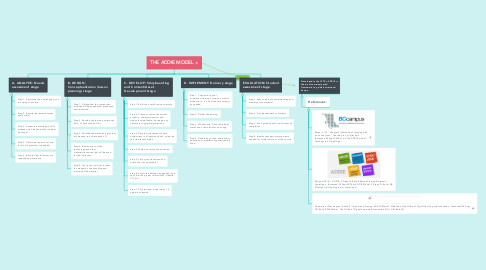THE ADDIE MODEL
by Kim Kane


1. B. DESIGN: Conceptualization (lesson planning) stage
1.1. Step 1. Outline how the content and activities will be sequenced, presented and reinforced.
1.2. Step 2. Develop the learning objectives (LOs) of each session/unit.
1.3. Step 3. Describe the methodologies that will be used to achieve each LO.
1.4. Step 4. Identify and cost the technology and other materials/resources that will be used for the instruction.
1.5. Step 5. Lay out how will you assess the students' understanding and mastery of the material.
2. A. ANALYZE: Needs assessment stage
2.1. Step 1. Determine the overall goals you are trying to achieve.
2.2. Step 2. Identify the learners/target audience(s).
2.3. Step 3. Assess the knowledge, skills, attitudes, and behaviors that need to be taught.
2.4. Step 4. Determine the amount and level of content that is needed.
2.5. Step 5. Identify what resources are required and available.
3. C. DEVELOP: Storyboarding and Content/Asset Development stage
3.1. Step 1. Build the overall course structure.
3.2. Step 2. Create or source the various graphics, characters/vectors and videos (as applicable), obtaining any necessary copyright permissions.
3.3. Step 3. Develop the content of each slide/screen in all sessions/units, using the selected technologies.
3.4. Step 4. Write and record the narration.
3.5. Step 5. Set up any transitions and animations (as applicable).
3.6. Step 6. Adjust the settings, as needed, and save into the proper format (LMS, website, CD, etc.).
3.7. Step 7. Pilot test and revise (steps 1-6 again) as needed.
4. D. IMPLEMENT: Delivery stage
4.1. Step 1. Conduct any prior orientation/training of support staff or students (i.e. in use of the technology), as needed.
4.2. Step 2. Deliver the training.
4.3. Step 3. Monitor use: Track completion status and other statistics on usage.
4.4. Step 4. Trouble-shoot and address any questions or problems experienced by users.
5. EVALUATION: Student assessment stage
5.1. Step 1. Assess learner's understanding and mastery of the material.
5.2. Step 2. Provide feedback to learners.
5.3. Step 3. Issue grades and/or certificates of completion.
5.4. Step 4. Identify changes/improvements needed for future iterations of the course.
6. Developed in the 1970s, ADDIE is the most commonly used framework to guide instructional design.
6.1. References:
6.1.1. Bates, A. W. "Chapter 4: Methods of teaching with an online focus." Teaching in a Digital Age. [Accessed 22 Sept 2018 at 4.3 The ADDIE model – Teaching in a Digital Age]
6.1.2. Ehogan (2018). "ADDIE: 5 Steps To Build Effective Training Programs." LearnUpon. [Accessed 22 Sept 2018 at ADDIE Model: 5 Steps To Build Effective Training Programs | LearnUpon]
6.1.3. University of Washington - Bothell. "Instructional Design: ADDIE Model." Website of the Office of Digital Learning and Innovation. [Accessed 22 Sept 2018 at ADDIE Model - The Office of Digital Learning & Innovation (DLI) - UW Bothell]
